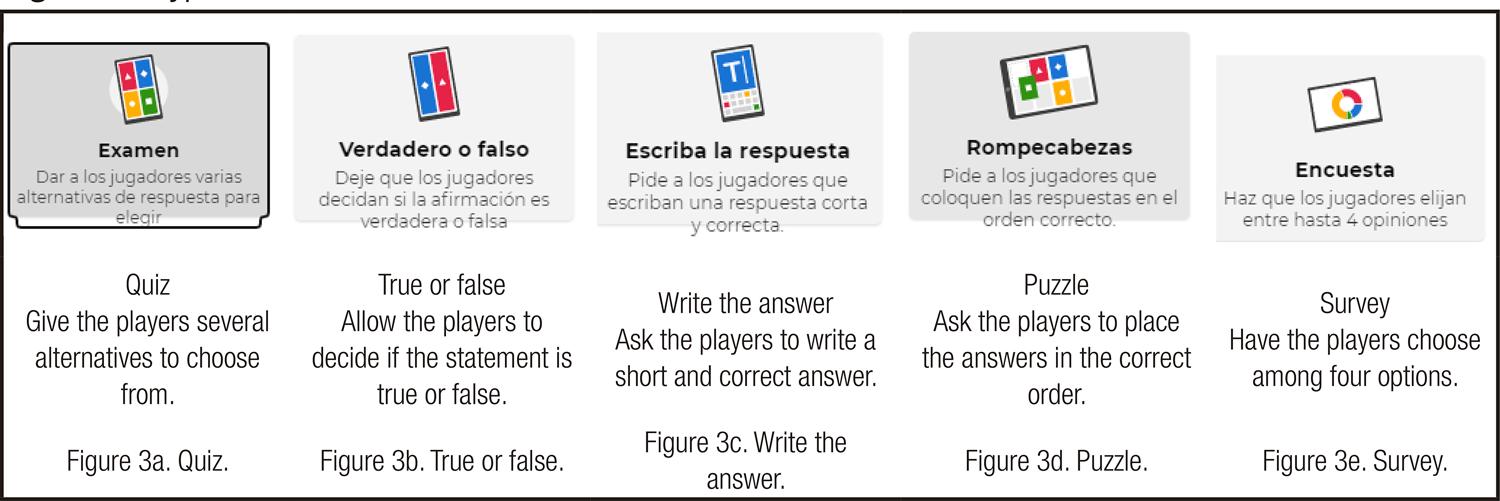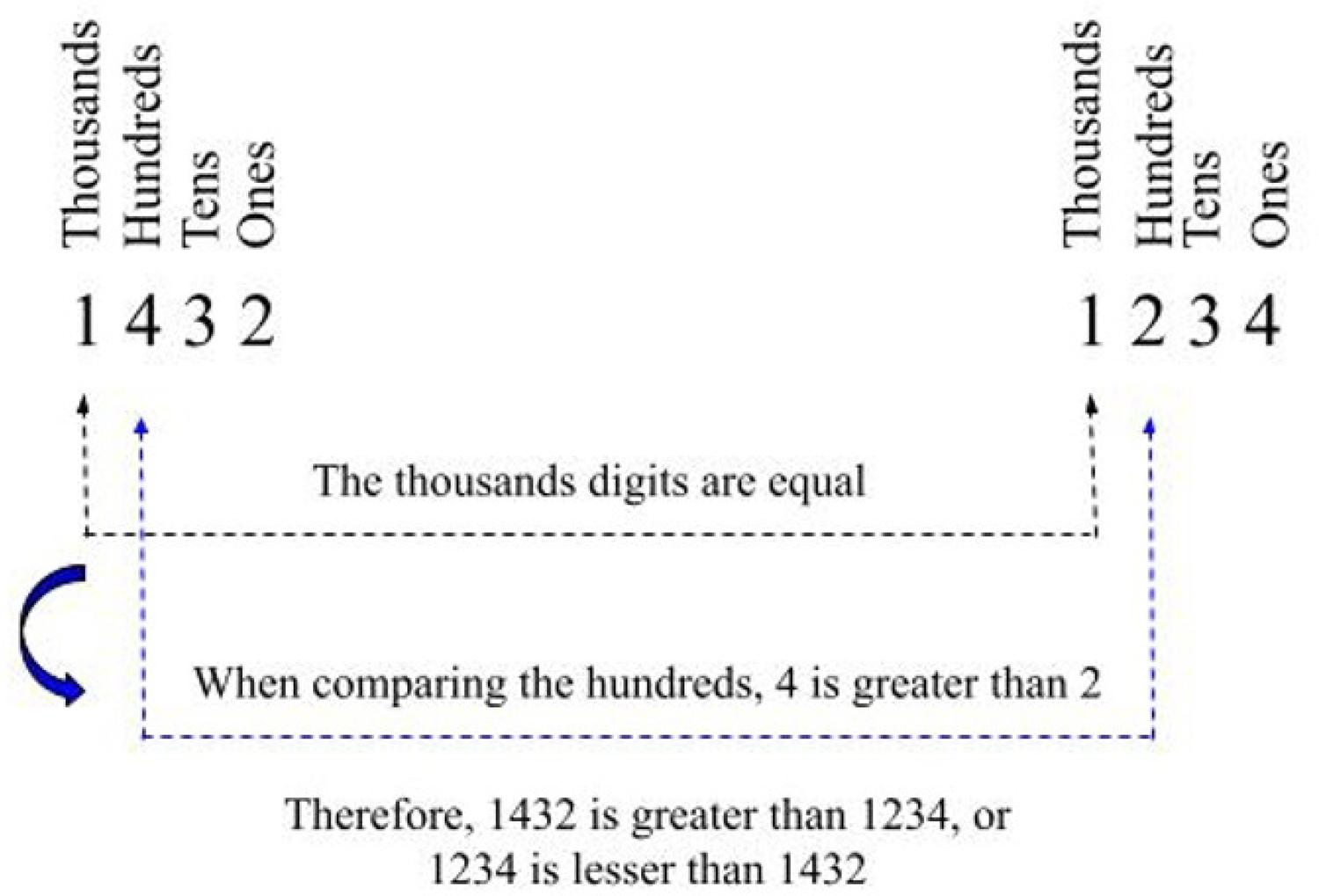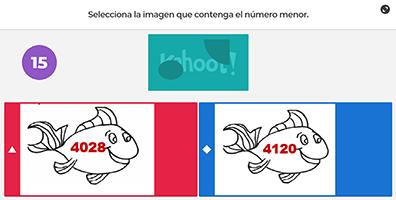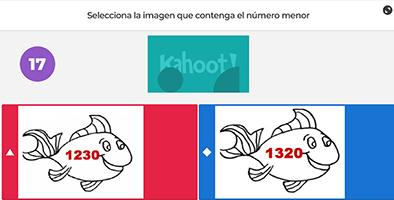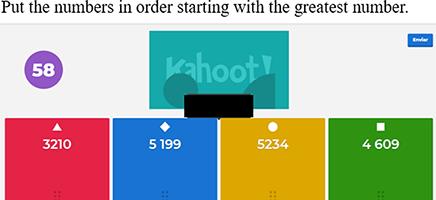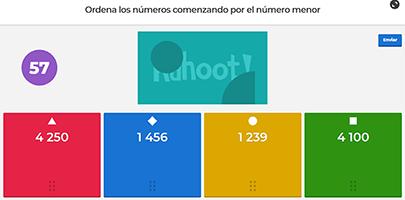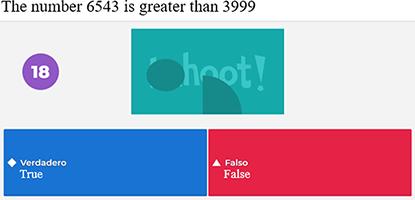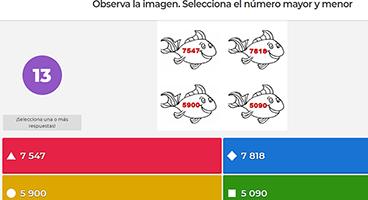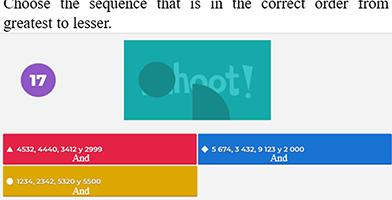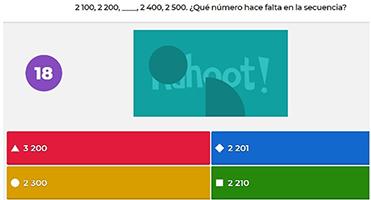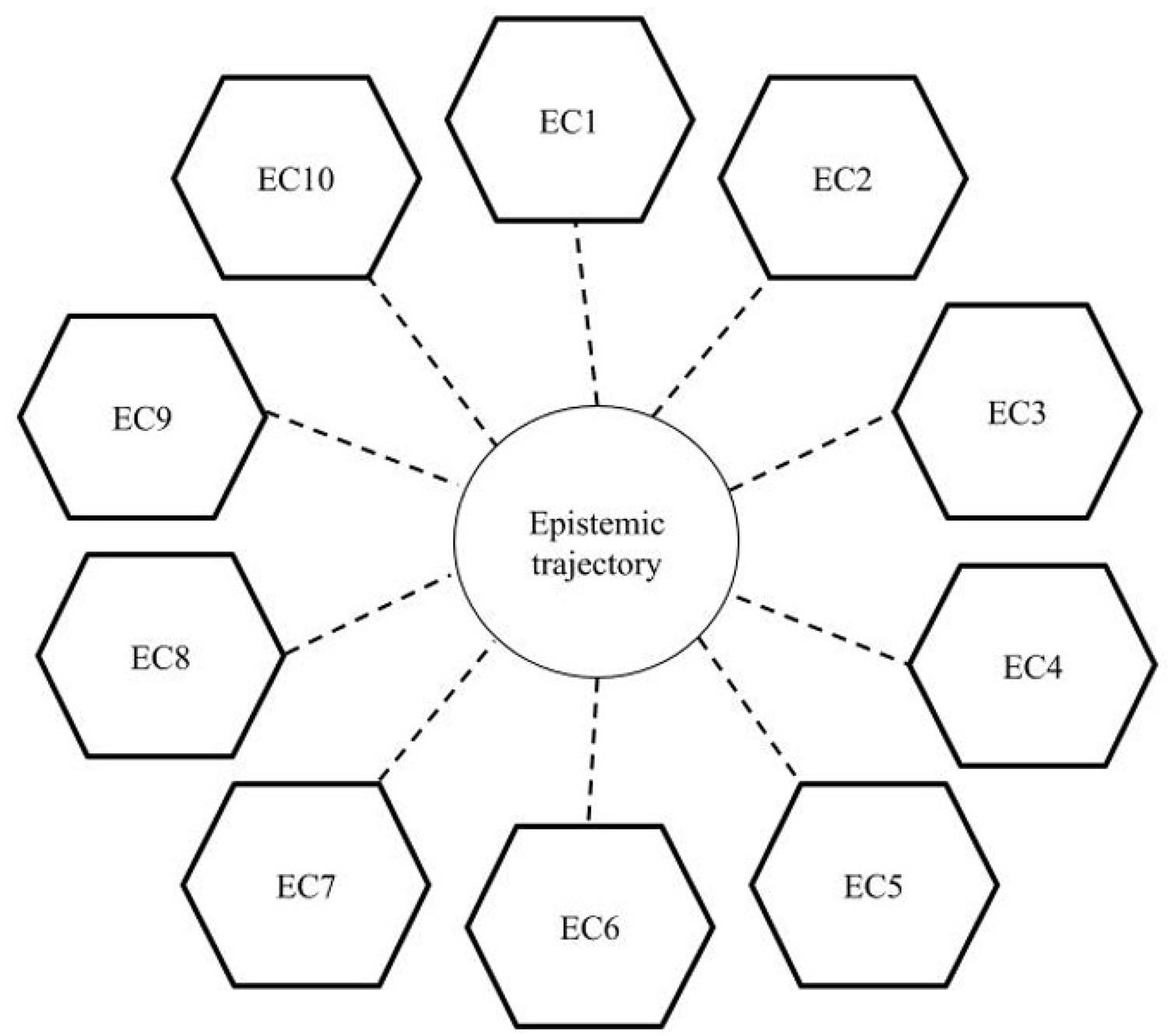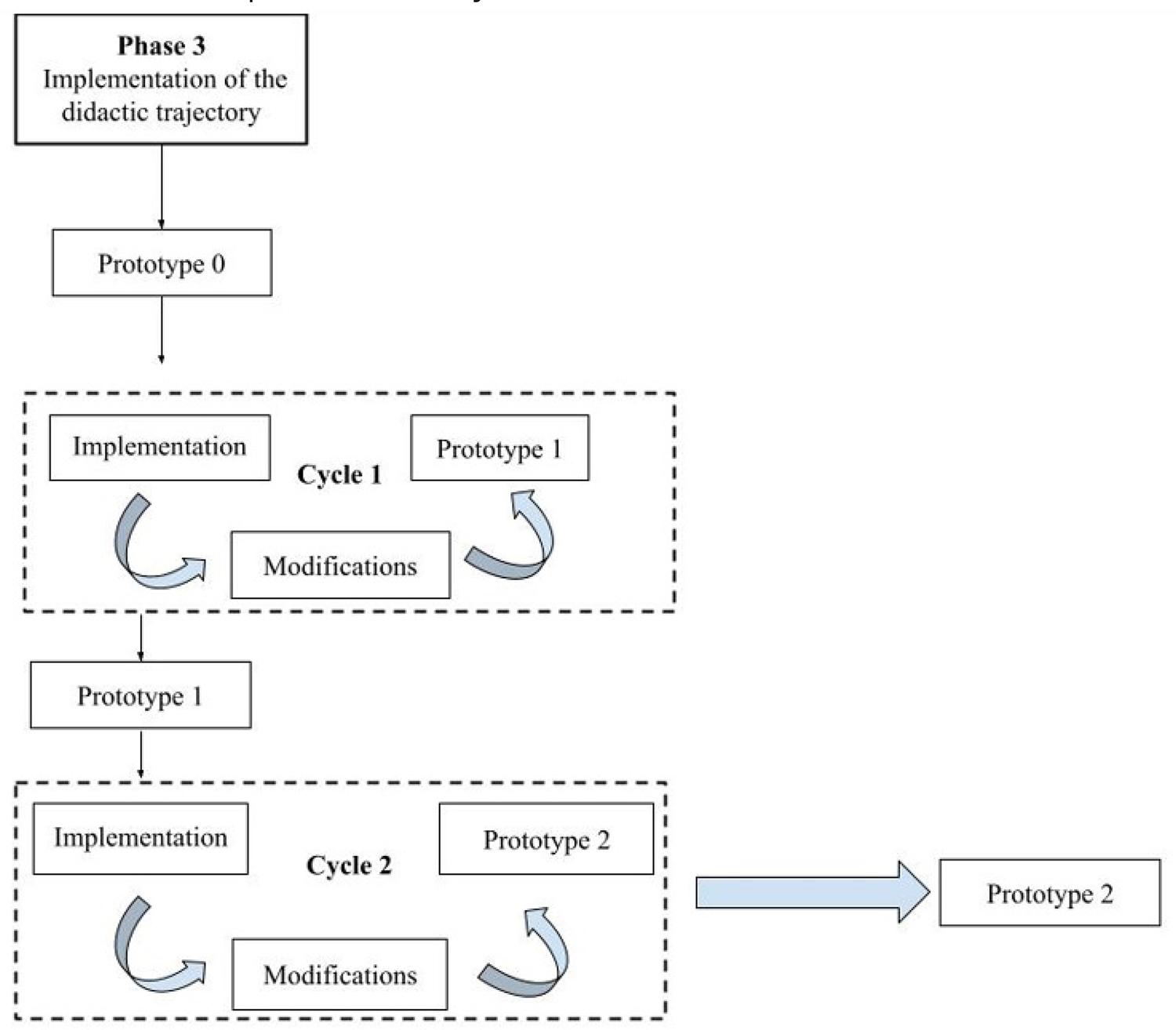Serviços Personalizados
Journal
Artigo
Compartilhar
Educação e Pesquisa
versão impressa ISSN 1517-9702versão On-line ISSN 1678-4634
Educ. Pesqui. vol.48 São Paulo 2022 Epub 27-Set-2022
https://doi.org/10.1590/s1678-4634202248259366esp
THEME SECTION: Education in health pandemic contexts COVID-19
2- Universidad Autónoma de Guerrero, México. Contacts: lmgarcia@uagro.mx; catalinans@uagro.mx; msgarcia@uagro.mx
In this research, tools of the Ontosemiotic Approach (OSA) were used to analyse the formative experience of two teachers in Primary Education service, guided towards the design and implementation of tasks for mobile learning, based on the meaning of the natural number and the use of Kahoot. The experience was developed during a workshop on the design of interactive lessons, where teachers were trained on the use of Kahoot for the design of mathematical content and its implementation in a real class context. Didactic engineering in the general sense of OSA was used as a methodological element. Specifically, the case of the design and implementation of an interactive lesson on the meaning of number sequence was analysed, where some results of the retrospective analysis of the formative experience indicated that: 1) the reference meaning of the natural number is a tool that allows to guide the design of tasks towards the partial meanings, the identification of primary objects, and the Ontosemiotic analysis of them; 2) the use of mobile devices and Kahoot together motivated the teachers. With these results, two training actions are proposed, aimed at teachers: 1) the design of mobile content from the reference meaning of the natural number, and 2) the assessment of the didactic suitability of teaching experiences mediated by mobile devices.
Key words: Training intervention; Mobile learning; Didactic engineering; Primary Education; Natural number; COVID-19 pandemic
En esta investigación se utilizaron herramientas del Enfoque Ontosemiótico (EOS) para analizar la experiencia formativa de dos profesores en servicio de Educación Primaria, orientada al diseño e implementación de tareas para el aprendizaje móvil, tomando como base el significado del número natural y el uso de Kahoot. La experiencia se desarrolló durante un taller sobre el diseño de lecciones interactivas, donde se capacitó a los docentes sobre el uso de Kahoot para el diseño de contenido matemático y su implementación en un contexto real de clase. Se utilizó como elemento metodológico la ingeniería didáctica en el sentido generalizado del EOS. Específicamente, se analizó el caso del diseño e implementación de una lección interactiva sobre el significado de secuencia numérica, donde algunos resultados del análisis retrospectivo de la experiencia formativa indicaron que: 1) el significado de referencia del número natural es una herramienta que permite orientar el diseño de tareas hacia los significados parciales, la identificación de objetos primarios y el análisis ontosemiótico de los mismos; 2) el uso de dispositivos móviles y el Kahoot motivó a los profesores. Con estos resultados, se proponen dos acciones formativas dirigidas a profesores: 1) el diseño de contenido móvil desde el significado de referencia del número natural y 2) la valoración de la idoneidad didáctica de experiencias de enseñanza mediadas por dispositivos móviles.
Palabras-clave: Intervención formativa; Aprendizaje móvil; Ingeniería didáctica; Educación primaria; Número natural; Pandemia de la COVID-19
Introduction
The COVID-19 pandemic worldwide changed the context regarding the teaching-learning of Mathematics, making most teachers move to a totally virtual field, where technological resources were the means of communication during the instruction process. In Mexico, the Ministry of Public Education (SEP) implemented the Learn at home program, which used television to broadcast preschool, primary, secondary, and high school education content, based on the official Curricula and Programs of Study (MEXICO, 2011; 2017). Likewise, through the Classroom and Teams platforms, teaching staff were trained during the period of isolation (MEXICO, 2020).
On the other hand, with COVID-19, research where technology, in addition to being a resource, is the means of communication has gained importance (FONT; SALA, 2020) and with it, teaching methods have been reported to be applied during the pandemic (e.g. CERVANTES-BARRAZA, 2021), and resources available online for the teaching of mathematical concepts (e.g. BARRIGA; BELTRÁN-PELLICER, 2021; PINCHEIRA; VASQUEZ, 2021; VALENZUELA; BATANERO; BEGUÉ, 2021). The above, as a response to support and face the challenge of teaching classes in virtuality (e.g., BAPTISTA et al., 2020).
In general, there are different trends about the introduction of technology in the teaching-learning process of Mathematics. This research is framed in mobile learning (CROMPTON, 2013a, 2013b; CROMPTON; BURKE, 2015, 2020) and the notion of Training Intervention of the Ontosemiotic Approach (GODINO et al., 2017; POSADAS; GODINO, 2017) and has as a research question: Which OSA tools can be used in a training intervention to achieve the implementation of mobile learning? For this reason, the objective is to: use OSA tools to analyse a training experience of two teachers in Primary Education service, guided towards the design and implementation of tasks for mobile learning.
Mobile learning in mathematics education
Over the past decade, interest in mobile technologies as emerging and innovative tools has grown (BENALI; ALLY, 2020). Mobile learning broadly involves the integration of mobile devices into teaching and learning (GRANT, 2019). There are different stances on the definition of mobile learning (e.g., BRAZUELO; GALLEGO, 2014; UNESCO, 2013) and mobile device (AGUILAR; PUGA, 2015; CROMPTON, 2013a; UNESCO, 2013) becoming a topic of discussion among the research community.
Properly in this research, mobile learning is “[...] learning through multiple contexts, through social and content interactions, using personal electronic devices” (CROMPTON, 2013b, p. 4). This definition includes three important aspects of the term, on the one hand, it involves the diversity of contexts where learning can take place, for example, at home, school, or outdoors, as well as the interactions that can be achieved between students or between the student and the mathematical content. It also refers to the use of personal electronic devices, understanding a mobile device as any personal and portable technological device that could be used in the mathematics classroom, including devices such as laptops, smartphones, and tablets (AGUILAR; PUGA, 2015).
Particularly, the use of mobile devices in the teaching-learning of Mathematics is gaining interest among researchers and education professionals (BORBA et al., 2016), and in Primary Education three main results can be highlighted:
Mobile learning has a positive impact on motivation, attitude, emotions, and interest in students and teachers (e.g., FABIAN; TOPPING; BARRON, 2018; MALIK et al., 2020).
Mobile applications have the potential to support the learning of mathematical concepts (e.g., CROMPTON, 2015; TUCKER; JOHNSON, 2020).
Teachers generally have a positive outlook on the use of mobile applications in the school context (e.g., HANDAL et al., 2015; INGRAM; WILLIAMSON-LEADLEY; PRATT, 2015).
However, research that reports on uses or potentialities that could be the basis for the implementation of mobile devices is limited in Mathematics Education (BORBA et al., 2016; SUNG; CHANG; LIU, 2016); in addition, in most researches, a specific mathematical concept is not identified (CROMPTON; BURKE, 2015). In this regard, Brazuelo and Gallego (2014) raised the need to promote the design of mobile educational content and prepare teachers as a key element for the real integration of mobile technologies for educational purposes. Therefore, it is important to guide teachers on the design and implementation of mobile content for the teaching of Mathematics.
Training intervention
This research was based on the Ontosemiotic Approach (OSA) which is understood as a modular and inclusive theoretical system for Mathematics Education, consisting of principles and methodological tools to address aspects related to the teaching and learning processes of mathematics (GODINO et al., 2021). It is considered that OSA can add elements that contribute to the previous problem, specifically there is research that reports training interventions related to “[...] the analysis of the didactic suitability of teaching experiences lived by the teachers themselves” (GODINO et al., 2017, p. 103). In general terms, in these interventions “[...] it is about the teacher reflecting on the design, implementation, and evaluation of a teaching experience of a specific topic in a fixed educational context” (p. 107).
The above, through the facets and criteria of didactic suitability (GODINO, 2013, 2021), understood as the degree to which an instruction process or part of it meets characteristics that allow it to be qualified as optimal or adequate to achieve adaptation between personal meanings achieved (learning) and the meanings intended or implemented (teaching), taking into account the circumstances and resources available (GODINO et al., 2021). Figure 1 presents the facets and criteria of didactic suitability.

Source: Created by the authors based on Godino (2021).
Figure 1 Facets and criteria of didactic suitability
This type of training action has been widely reported in research carried out by the OSA. For example, Morales, García, and Durán (2019) designed and implemented a training proposal for the development of the mathematical knowledge and competence profile of teachers, where they identified incidents or recurrences of each component of the didactic suitability. Pochulu, Font, and Rodríguez (2016) carried out a training cycle aimed at teacher trainers of mathematics, guided towards the design of tasks for the development of the didactic analysis competence, where the suitability criteria were used in the planning of the task sequences. Giacomone, Godino, and Beltrán-Pellicer (2018) analysed and evaluated the implementation of a training design for the development of the competence of analysis of didactic suitability. Meanwhile, Aké and other authors (2014) analysed a training experience of teachers, guided towards the development of knowledge to discriminate algebraic objects and levels of algebraization of mathematical activity.
In this case, the analysis of a training experience guided towards the design and implementation of tasks for mobile learning is presented, based on the experience lived by two in-service teachers, with the teaching of the meaning of numerical sequence and the use of Kahoot. To this end, didactic suitability, and other theoretical tools of the OSA were used, which are presented in the following section.
Methodological elements
Given the nature of the objective, this research is qualitative; it was framed in an exploratory-descriptive approach (HERNÁNDEZ; FERNANDEZ; BAPTISTA, 2014) and a design research methodology was applied, based on the use of OSA tools (POCHULU; FONT; RODRÍGUEZ, 2016) in a real classroom context. In line with the above, this study involved the design/planning, implementation, and retrospective analysis of a training experience (GIACOMONE; GODINO; BELTRÁN-PELLICER, 2018) aimed at in-service teachers of Primary Education, which was organised in five stages: 1) previous instruction for the management of Kahoot, which is an educational platform to design content on mobile devices; 2) instruction on the diversity of meanings associated with the concept of study, in this case, natural number; 3) design of interactive lessons in Kahoot on the meaning of natural number; 4) planning a class to introduce an interactive lesson in a real classroom context; and 5) implementation and validation of the interactive lesson.
The development of the formative experience was based on didactic engineering understood from the expanded perspective of the OSA (GODINO et al., 2014) considering its potentiality as a methodological element that guides the design, implementation, and evaluation, as well as the orchestration of the theoretical tools used during the training experience. The goal in the use of engineering is to show how some OSA tools can be used in the design and implementation of mobile content for the teaching of the natural number. Figure 2 shows the phases of this didactic engineering.

Source: Created by the authors based on Godino and other authors (2014).
Figure 2 Phases of didactic engineering
The phases and the theoretical tools used in each case are described below.
Preliminary analysis. This phase is guided by the notion of reference meaning of the mathematical object, which is focused on the systematic analysis of the literature for the identification of the various meanings of the objects and their articulation in a global meaning, “[...] this global meaning is considered as the reference population (of situation-problems) from which samples appropriate to the particular circumstances of the processes to be designed will be selected” (GODINO et al., 2017, p. 94). For this reason, in this phase, the reference meaning of the natural number was established, according to the literature review.
Design of the didactic trajectory. Among other aspects, it consists of the selection of situation-problems, sequencing, and a priori analysis of them (GODINO et al., 2014). This phase focused on the design of tasks (problem-situations) in Kahoot, their sequencing, and a priori analysis. Also, the planning of a class was requested to achieve the implementation of some tasks. In accordance with the above, the theoretical notions of epistemic trajectory were used, understood as the distribution of primary objects (situation-problems, language, procedures, concepts, propositions, and arguments) in an instruction process (GODINO; CONTRERAS; FONT, 2006), for this, ontosemiotic analysis was used (MORALES-GARCIA; DÍAZ-LEVICOY, 2022; MORALES-GARCIA; NAVARRO; DÍAZ-LEVICOY, 2021) and epistemic configuration (FONT; GODINO, 2006), as well as the teaching trajectory, understood as the actions of the teacher in the planning of the instruction process (GODINO; CONTRERAS; FONT, 2006).
Implementation of the didactic trajectory. Focused, among other aspects, on the observation of interactions between people and resources (GODINO et al., 2014), in this case, the interactions between people and the technological resource used in the design of tasks. Consequently, two implementation cycles were carried out, in order to validate and refine the tasks. In each cycle, Significant Didactic Facts (SDF) were identified, understood as any event that has a place and a time in the evolution of a process of mathematical instruction (WILHELMI; FONT; GODINO, 2005).
Retrospective analysis. It focuses on reflection on the didactic suitability of the instructional process (GODINO et al., 2014). In this phase, the indicators of didactic suitability (GODINO, 2013, 2021) were taken to reflect on the suitability of the design and implementation of tasks measured by mobile devices.
Design of the training process
Participants and context
Two in-service Primary Education teachers participated in the training experience, whose information is shown in Table 1.
Table 1 Personal data of participants
| Participant | Age | Academic background | Teaching experience (years) |
|---|---|---|---|
| Teacher1 | 28 | Bachelor of Science in Mathematics | 4 |
| Teacher2 | 28 | Bachelor’s Degree in Primary Education | 3 |
Source: Own creation.
Teacher1 was a teacher in a private school, where they taught Mathematics to two 3rd grade groups, 3A (22 students) and 3B (24 students). At the time of the investigation, the health emergency due to COVID-19 occurred worldwide, and in accordance with the guidelines of the Ministry of Public Education, classes were taught virtually. Particularly, Teacher1 used Zoom to teach classes by video call, synchronously using a computer, a tablet, and a smartphone. On the other hand, Teacher2 taught in a public school, to the sole 3rd-grade group (21 students) virtually in an asynchronous format, using a smartphone and WhatsApp messaging.
Technological resource
For the design of tasks, Kahoot (https://kahoot.com/schools-u) was used, a technological resource that allows teachers to design interactive activities (tasks) that can be seen on a smartphone, tablet, and computer. This resource is interactive and intuitive and allows you to design tasks without the need for advanced knowledge about programming, the latter being the reason why it was selected.
In the premium version of Kahoot, the following tasks can be designed: a) quiz (Figure 3a); b) true or false (Figure 3b); c) write the answer (Figure 3c); d) puzzles (Figure 3d); and e) survey (Figure 3e). In addition, in the resource, each task is assigned a time limit to respond, which ranges anywhere from 5 seconds to 4 minutes.
Data collection
Both teachers received training in task design in the Designing interactive lessons in Kahoot workshop given over the course of eight weeks. In response to COVID-19 restrictions, the workshop was held synchronously via Google Meet. In total, there were eight sessions that were recorded (one session each week) with an approximate duration of 2 hours. Likewise, Google Classroom was used to work on activities that supplemented the information presented in the virtual sessions. Excerpts were taken from the recordings for analysis, and from Classroom activities, the planning of a class was taken as evidence. Table 2 shows the purpose of each workshop session.
Table 2 Purpose of the workshop sessions
| Session | Purpose |
|---|---|
| 1 | Know the general characteristics of Kahoot |
| 2 | |
| 3 | Know the reference meaning of the natural number |
| 4 | |
| 5 | Design assignments and plan a class |
| 6 | |
| 7 | Implementation and validation of tasks |
| 8 |
Source: Own creation.
Sessions 1 and 2 addressed aspects related to creating an account, the type of tasks, configuring tasks, among other functions of the resource. In sessions 3 and 4, the reference meaning of the natural number was discussed, emphasizing the type of situation-problems and the mathematical practices associated with each partial meaning of the mathematical object. Sessions 5 and 6 were devoted to the design of assignments and the planning of a class in which they were incorporated. Finally, in sessions 7 and 8 the tasks were implemented and validated; in the first moment, between the first author (researcher) and the participating teachers of the workshop, and in the second moment with the students of each teacher.
In general terms, the training experience consisted of providing two in-service teachers with specific knowledge about the use of Kahoot and the reference meaning of the natural number for the design of tasks. Subsequently, teachers were asked to plan and implement an instructional process that involved the tasks designed; and finally, the didactic suitability of the training experience was analysed.
Results
In the following sections, the training experience is described by making a distinction between the four phases of didactic engineering and the use of the theoretical elements of the OSA.
Preliminary analysis
In this phase, the reference meaning of the natural number in the Decimal Numbering System (DNS) was reconstructed from its contexts of use (MORALES-GARCIA; NAVARRO, 2021) and the system of practices involved, organised in epistemic configurations (EC) (MORALES-GARCIA; NAVARRO; DÍAZ-LEVICOY, 2021). In line with the above, six partial meanings of the natural number were established (Figure 4).
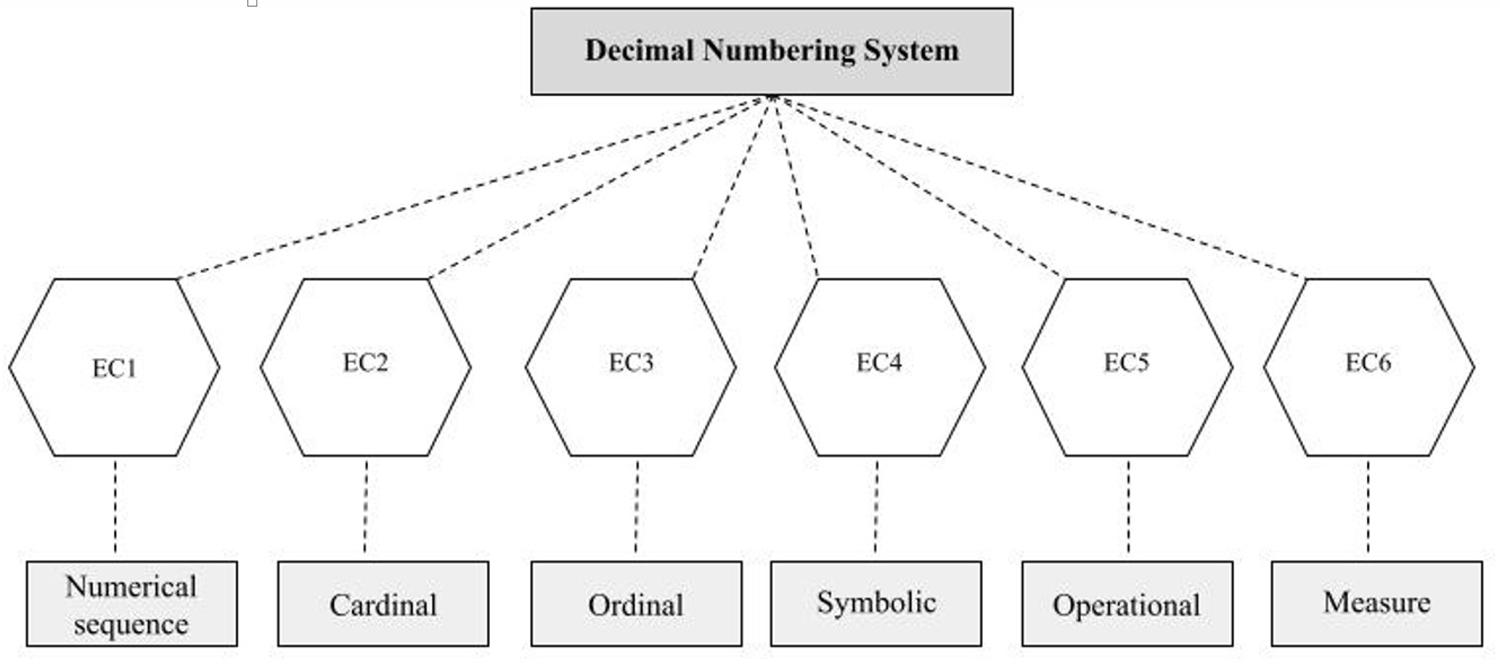
Source: Morales García and Navarro (2021, p. 1344).
Figure 4 Reference meaning of the natural number in the Decimal Number System
Each meaning is described below.
Meaning of numerical sequence. Consider using the natural number to indicate the order for reciting or writing the sequence of natural numbers. For example, recite the sequence of numbers from 1 to 30.
Meaning of cardinal. Using the number to indicate how many elements are in an assembly. For example, count the number of apples in a basket.
Ordinal meaning. Numbers are used to indicate the position of an object in an ordered assembly. For example, indicating the runner’s finishing position is in an athletics race.
Symbolic meaning. In this case, numbers are used as tags to identify objects. For example, the numbers on the shirts of football players.
Operational meaning. The use of numbers to perform arithmetic operations is highlighted. For example, calculate the result of 30+2.
Meaning of measure. Among other aspects, the use of numbers to indicate how much an object or person measures. For example, indicate the length of a book.
Design of the didactic trajectory
In this phase, the teachers designed interactive lessons that were based on the tasks available in Kahoot (quiz, true or false, write the answer, puzzles, and survey) and the partial meanings of the natural number (cardinal, ordinal, numerical sequence, operational, measure, or symbolic). The designs were made after four sessions of the workshop, namely, based on the teachers’ knowledge of Kahoot management (Sessions 1 and 2), and knowledge of the reference meaning of the natural number (Sessions 3 and 4). Each interactive lesson was made up of 10 tasks and addressed one of the partial meanings of the natural number. Table 3 contains specific information.
Table 3 Interactive lessons designed by the participants
| Participant | Meaning of the natural number | Interactive lesson | Number of tasks |
|---|---|---|---|
| Teacher1 | Number sequence | Four-digit number | 10 |
| Order and sequence | 10 | ||
| Operational | Basic operations | 10 | |
| Mental calculation 1 | 10 | ||
| Ordinal | Ordinal numbers | 10 | |
| Measure | Longitude | 10 | |
| Teacher2 | Number sequence | Which is greater? | 10 |
| Number sequence | 10 | ||
| Operational | Basic operations | 10 | |
| Additive decomposition | 10 | ||
| Ordinal | Ordinal numbers | 10 | |
| Total 11 | 110 | ||
Source: Own creation.
In this research, and to show the potential of the theoretical tools of the OSA, the didactic trajectory involved in the design and implementation of the interactive lesson order and sequence created by Teacher1 is analysed. In this sense, the objective pursued in this phase was to identify the actions that Teacher1 considered before the implementation of the interactive lesson in a real context (teaching trajectory) and the effectively implemented meaning of the natural number as a numerical sequence (epistemic trajectory).
On the teaching trajectory, and in accordance with the planning of Teacher1, this teacher organises their class in three moments: beginning, where they present an introduction to the topic being studied, usually with some video about the content of the class; later in the development they work with activities included in their textbook, and finally, in the closing, some elements presented throughout the class that will not be clear, are discussed, and it is at this time where Teacher1 incorporated the interactive lesson order and sequence that in the words of Teacher1 “[...] will serve to reinforce the content worked on in the class sessions.” In that sense, the students had previous knowledge on how to solve the situation-problems established in the interactive lesson, which somehow allows greater success in their resolution.
Teacher1: [...] on Friday we write down in the notebook, how we can compare two numbers [natural numbers]; let’s start by comparing the thousands [the absolute value of the thousands] if they are equal, we go to the hundreds [we compare the absolute value of the hundreds]; if they are equal, we go to the tens [the absolute value of the tens], if they are equal, we go to the ones [the absolute value of the ones]. That’s why I put these activities [tasks in the interactive lesson].
The procedure suggested by Teacher1 to determine when one number is greater than or less than another is to make comparisons between the absolute value of the digits of the compared numbers, starting with the digit of greater order (Figure 5).
In summary, Teacher1 considered as important actions to address the procedure beforehand, during the beginning and development of the class. In that sense, the application of the interactive lesson was considered as a kind of evaluation of the learning achieved by the students on the comparison of natural numbers with the intention of reinforcing the content taught, hence the importance of including it in the closing of the class.
On the other hand, in the epistemic trajectory of the interactive lesson, the problem situations, the sequence of expected practices in their resolution, and the primary objects involved in each task are shown. This information was obtained by considering the speech of Teacher1 when presenting the 10 tasks (session 7) that made up the interactive lesson and the description of each task, included in the planning of the class. Table 4 presents the ontosemiotic analysis (MORALES-GARCIA; DÍAZ-LEVICOY, 2022; MORALES-GARCIA; NAVARRO; DÍAZ-LEVICOY, 2021) of the tasks, identifying in the situation-problem the expected response and the time allocated for its response, the sequence of operational and discursive practices necessary to solve the task, and the primary objects involved in the resolution of each situation-problem.
Table 4 Ontosemiotic analysis of the interactive lesson order and sequence
Source: Own creation.
The analysis of the epistemic trajectory (Figure 6) of the interactive lesson is important to show the effectively implemented meaning of the studied concept, in this case, the numerical sequence meaning of the natural number. For its analysis, the sequence of practices and the primary objects identified in each task, organised in epistemic configurations (EC), were considered. For example, the primary objects identified in Task 1 make up epistemic configuration 1 (EC1), the primary objects of Task 2, EC2, and so on for each task. It should be noted that each epistemic configuration has a function in the instruction process, for example, in EC1, EC2, EC3, and EC6 it was intended to put into practice the procedure taught for the comparison of two, four-digit natural numbers. Whereas, in EC4 and EC5 the procedure taught was applied, to put in order (ascending or descending) four numbers. On the other hand, in EC7 the level of difficulty was increased in some way since it is necessary to select among four numbers: the greatest and the least. In EC8 it was selected among three number sequences, which was correctly ordered from greater to lesser. In EC9 it was asked to indicate which is the number that completes the number sequence; here the student’s ability to recognise how much a number sequence increases and consequently identify which number completes it correctly is evaluated. Finally, in EC10 another procedure is presented to distinguish when one number is greater than another, considering the number of digits.
Implementation of the didactic trajectory
The tasks designed by Teacher1 and analysed above make up Prototype 0 of the interactive lesson order and sequence. This was implemented twice; each implementation cycle was intended to validate and refine the included tasks by identifying Meaningful Didactic Facts (WILHELMI; FONT; GODINO, 2005). Figure 7 shows the deployment cycles.
The following describes the Significant Didactic Facts (SDF) identified in the implementation cycles.
Task content (SDF1). Related to the mathematical content of the task. For example, errors in the order of answers or in the understanding of the task.
Time (SDF2). Related to the time allocated to respond to each of the tasks. For example, the time allotted to answer Task 1 was not enough.
Interaction with the technological resource (SDF3). Related to failures in the interaction with Kahoot. For example, you cannot answer tasks from your computer.
Cycle 1 of the application was carried out with the participants of the workshop, in this case, the person in charge of the workshop and first author (I) and Teacher2 answered the 10 tasks that made up the lesson of Teacher1, to discuss their relevance (session 7). Based on this implementation, some adjustments were made to prototype 0. The first modification was made to Task 5 since the response options were not ordered from lesser to greater (SDF1).
Teacher2: [...] I think that Task 5, is wrong because it was to order from lesser to greater the four numbers, and so I did, but it turns out that my answer is wrong.
Teacher1: you are right I think that in this task I was wrong when indicating the order in the numbers I must edit the answer in Kahoot, to resolve it.
The other modification was guided towards the time assigned to Task 8, where it was asked to select the numerical sequence that was correctly ordered from greater to lesser. Here initially Teacher1 had assigned 20 seconds to respond, but according to the demand of the task, it is concluded that the time should be increased (SDF2) and that it should be increased to 40 seconds.
Teacher2: you do not think that, in this task, you would have to give it more time, 20 seconds is very little.
Teacher1: I think so, here I see that 20 seconds is very little, and the task demands a lot of activity [comparisons between numbers] on the part of the students because they must analyse each of the sequences.
I: You are correct, because there are three sequences, and the time must be increased [...]
The modifications made to prototype 0 were applied to the tasks, now generating Prototype 1 of the interactive lesson. In Cycle 2, Teacher1 applied Prototype 1, but now to their 46 students in the 3rd grade of Primary Education. The results according to the Kahoot report (shows the percentage of correct answers), allowed to identify three difficult tasks; the first was Task 5 of the puzzle type. Here Teacher1 pointed out that the students presented difficulties to drag the answer options on the computer (SDF3), since these returned to the initial place, and in the end only 8% of the answers were correct.
I: And how did the students do?
Teacher1: At first, they found it difficult to sort numbers [Kahoot’s puzzle task] [...] because as you move them on the computer [the answer options] they move again [it was not as they wanted to order them], but I told them not to worry that they could try again.
The second task is Task 7, where it was asked to select the greatest and least number, and you had 20 seconds to respond. Here only 27% of the students had correct answers, with the allotted time being insufficient to respond, so it was increased to 60 seconds (SDF2). The third task is 8, where it was asked to select the sequence that was correctly ordered from greater to lesser; for this, 40 seconds were available. In this case, only 31% of the answers were correct; for this reason, the modifications were focused on increasing the time to 60 seconds (SDF2) and/or changing the type of task (SDF1), trying to use fewer number sequences to decrease the process and reach the solution. The modifications made to Prototype 1 were applied to the tasks, allowing to generate Prototype 2 of the interactive lesson order and sequence.
Teacher1: [...] the most difficult tasks were Tasks 5, 7, and 8.
I: What happened in Task 7?
Teacher1: I think that there the time was not enough, I will increase the time to 60 seconds.
I: And what can you say about Task 8?
Teacher1: [...] well here I think it was the type of task [include three number sequences], although in the notebook we had already seen some examples, at the beginning [...] of the sessions, but still the understanding or I do not know [...].
Teacher2: ... or time.
Teacher1: yes, perhaps time...
Teacher2: How much time did you assign?
Teacher1: 40 seconds.
I: If you think it wasn’t enough, you can increase it to 60 seconds.
Teacher1: [...] I still must work more on this type of task.
Retrospective analysis of the training experience
In this last phase, the retrospective analysis was carried out using the components of didactic suitability (Figure 8). In line with the above, Table 5 presents the assessment of the epistemic, cognitive, affective, mediational, interactional, and ecological facets of the formative experience (GODINO, 2013).
Table 5 Didactic suitability of the training experience
| Facet | Assessment |
|---|---|
| Situation-problems, language, procedures, concepts, propositions, and arguments conformed to the nature of the numerical sequence meaning. | |
| Students found it difficult to apply the procedure when homework required comparing more than two, four-digit numbers. This is due to the cognitive demand involved in applying the taught procedure, in numerical sequences of four natural numbers. | |
| Teachers and students were motivated during the design and implementation of the interactive lesson. Which suggests that the use of mobile devices positively impacts motivation. | |
| On the availability of mobile devices, in this case, in the context of the pandemic, participants had mobile devices to carry out the design and implementation, such as a computer, tablet, or smartphone, as well as internet access. | |
| The teacher interacted synchronously, that is, they addressed only and exclusively their students who were connected, with their mobile devices to complete the tasks; and this allowed to identify and solve difficulties to adapt to the type of questions included in the interactive lesson. | |
| In this regard, the teacher had the necessary conditions to carry out distance learning, such as access to the internet, mobile devices, and their students also had these resources. Since they were used to working through Zoom the teacher had no problems in the development of the instructional process. |
Source: Own creation.
Discussion
In this research, a formative experience of two in-service Primary Education teachers was analysed, guided towards the design and implementation of tasks for mobile learning, based on the meaning of the natural number and the use of Kahoot. To this end, didactic engineering understood from the perspective of the OSA (GODINO et al., 2014) and its tools (GODINO, 2021; GODINO et al., 2017) allowed for the design, implementation, and analysis of the training experience. In addition, it made it possible to answer the research question: Which OSA tools can be used in a training intervention to achieve the implementation of mobile learning?
In line with the above, in the preliminary phase, the notion of reference meaning of the natural number (MORALES-GARCIA; NAVARRO, 2021) guided the type of tasks that could be designed, from the epistemology of the intended mathematical content (AKÉ et al., 2014). The above is a contribution to mobile content design (BRAZUELO; GALLEGO, 2014), given that, in most researches, a specific mathematical concept studied is not identified (CROMPTON; BURKE, 2015). In this sense, considering the reference meaning of the natural number allowed to support the type of situation-problems that can be raised with respect to this mathematical content.
In the design phase, the notions of epistemic trajectory (GODINO et al., 2006), Ontosemiotic analysis (MORALES-GARCIA; DÍAZ-LEVICOY, 2022; MORALES-GARCIA; NAVARRO; DÍAZ-LEVICOY, 2021), and epistemic configuration (FONT; GODINO, 2006) allowed to organise the frame of primary objects associated with the meaning of number sequence in the designed tasks. On the other hand, the notion of teaching career (GODINO; CONTRERAS; FONT, 2006), guided the analysis of the actions that the teacher considered necessary to achieve, in this case, the integration of the interactive lesson order and sequence in a real class context.
In the implementation phase, the notion of significant didactic fact (WILHELMI; FONT; GODINO, 2005) allowed to identify, in the cycles of application of the prototype of the interactive lesson, aspects that would allow to improve the tasks for its implementation in a real class context. In the retrospective analysis phase, the use of Godino’s didactic suitability indicators (2013, 2021) allowed a systematic reflection on the implemented formative experience, which made it possible to establish potential improvements in the process.
In this sense, the retrospective analysis of the formative experience highlights six aspects: 1) the reference meaning of the natural number guided the design of tasks towards partial meanings, the identification of primary objects, and the Ontosemiotic analysis of them; 2) the previous knowledge that the student has about the objective of each interactive lesson must be clear; 3) the use of mobile devices and Kahoot motivate teachers and students; 4) the device that caused problems because of its use was the computer, and only with the puzzle-type tasks; 5) it would be important for teachers to incorporate the interactive lesson at the beginning and the development of the class, and not only in the closing; and 6) the context where mobile learning is used must have the availability of mobile devices, internet access, and a good organisation of the class.
On mobile learning, it is confirmed that it has a positive impact on affective aspects, in this case, motivation (FABIAN; TOPPING; BARRON, 2018; MALIK et al., 2020). In addition, the mobile content designed has the potential to support the learning of mathematical concepts (CROMPTON, 2015; TUCKER; JOHNSON, 2020), in this case, the natural number.
Also, considering the context of the health emergency due to COVID-19, it is important that teachers not only have knowledge about the resources that are available online (BARRIGA; BELTRÁN-PELLICER, 2021; PINCHEIRA; VASQUEZ, 2021; VALENZUELA; BATANERO; BEGUÉ, 2021), but also be able to incorporate them into the school context. Consequently, it is essential to carry out research on training actions that guide teachers on the design, implementation, and evaluation of mobile content for the teaching of specific mathematical concepts. This can be achieved since teachers generally have a positive outlook on the use of mobile applications in the school context (HANDAL et al., 2015; INGRAM; WILLIAMSON-LEADLEY; PRATT, 2015).
In this sense, with this research two training actions are proposed, aimed at in-service teachers: the first is the design of mobile content from the reference meaning of the natural number and its ontosemiotic analysis. The second training action is the assessment of the didactic suitability of teaching experiences mediated by mobile devices through the analysis of class episodes of the teachers themselves. According to Arjona-Heredia and Gámiz-Sánchez (2013), the detailed analysis of training experiences can draw revealing conclusions about the possible use of mobile learning in the educational field, therefore, the development of research that informs on this topic is open.
Conclusions
Mobile learning in the teaching-learning of Mathematics is gaining interest in the research community (e.g., BORBA et al., 2016; CROMPTON, 2015), and mobile devices are considered as emerging and innovative tools (BENALI; ALLY, 2020). However, although there are different investigations that show the potential they have in the teaching-learning of mathematical concepts, it is considered that the studies should be guided towards promoting the design of mobile content by the teachers themselves, from the two training actions presented above, where the theoretical and methodological tools of the OSA play an important role.
Therefore, this research contributes to the knowledge about the use of other facets of OSA, such as cognitive, interactional, affective, and ecological suitability for the analysis of the didactic suitability of mobile learning, as it was well recommended in Morales-Garcia, Navarro, and García González (2022). On the other hand, although there are various resources for the design of content on mobile devices, in this case, Kahoot turned out to be a technological resource of easy use, and intuitive for in-service teachers.
REFERENCES
AGUILAR, Mario; PUGA, Danelly. Mobile help seeking in mathematics: an exploratory study with Mexican engineering students. In: CROMPTON, Helen; TRAXLER, John (ed.). Mobile learning and mathematics: foundations, design, and case studies. Florence: Routledge, 2015. p.176-186. [ Links ]
AKÉ, Lilia et al. Ingeniería didáctica para desarrollar el sentido algebraico de maestros en formación. Aiem, Madrid, n. 5, p. 25-48, 2014. https://doi.org/10.35763/aiem.v1i5.70 [ Links ]
ARJONA-HEREDIA, José; GÁMIZ-SÁNCHEZ, Vanesa. Revisión de opciones para el uso de la plataforma Moodle en dispositivos móviles. Red, Murcia, n. 37. p. 1-15, 2013. [ Links ]
BAPTISTA, Pilar et al. Encuesta nacional a docentes ante el Covid-19. Retos para la educación a distancia. Revista Latinoamericana de Estudios Educativos, Ciudad de México, v. 50. n. esp., p. 41-88, 2020. https://doi.org/10.48102/rlee.2020.50.ESPECIAL.96 [ Links ]
BARRIGA, Belén; BELTRÁN-PELLICER, Pablo. Una propuesta de adaptación del juego Dixit empleando tarjetas WODB con contenido matemático. Tangram, Dourados, v. 4. n. 2, p. 134-154, 2021. http://dx.doi.org/10.30612/tangram.v4i2.14533 [ Links ]
BENALI, Mourad; ALLY, Mohamed. Towards a conceptual framework highlighting mobile learning challenges. International Journal of Mobile and Blended Learning, Hershey, v. 12, n. 1, p. 51-63, 2020. [ Links ]
BORBA, Marcelo et al. Blended learning, e-learning and mobile learning in mathematics education. ZDM-Mathematics Education, Berlín, v. 48, n. 5, p. 589-610, 2016. https://doi.org/10.1007/s11858-016-0798-4 [ Links ]
BRAZUELO, Francisco; GALLEGO, Domingo. Estado del mobile learning en España. Educar em Revista, Curitiba, n. 4, p. 99-128, 2014. https://doi.org/10.1590/0104-4060.38646 [ Links ]
CERVANTES-BARRAZA, Jonathan. Una propuesta metodológica para elaborar videos creativos en clase de geometría. Cultura Educación y Sociedad, Barranquilla, v. 12. n. 2, p. 79-94, 2021. https://doi.org/10.17981/cultedusoc.12.2.2021.05 [ Links ]
CROMPTON, Helen. A historical overview of mobile learning: toward learner-centered education. In: BERGE, Zane; MUILENBURG, Lin (ed.). Handbook of mobile learning. Florence: Routledge, 2013b. p.3-14. [ Links ]
CROMPTON, Helen. Mobile learning: new approach, new theory. In: BERGE, Zane; MUILENBURG, Lin (ed.). Handbook of mobile learning. Florence: Routledge, 2013a. p. 47-57. [ Links ]
CROMPTON, Helen. Understanding angle and angle measure: a design-based research study using context aware ubiquitous learning. International Journal for Technology in Mathematics Education, Plymouth, v. 22. n. 1, p. 19-30, 2015. https://doi.org/10.1564/tme_v22.1.02 [ Links ]
CROMPTON, Helen; BURKE, Diane. Mobile learning and pedagogical opportunities: a configurative systematic review of PreK-12 research using the SAMR framework. Computers & Education, United Kingdom, v. 156, p. 103945, 2020. https://doi.org/10.1016/j.compedu.2020.103945 [ Links ]
CROMPTON, Helen; BURKE, Diane. Research trends in the use of mobile learning in mathematics. International Journal of Mobile and Blended Learning, Hershey, v. 7. n. 4, p. 1-15, 2015. https://doi.org/10.4018/IJMBL.2015100101 [ Links ]
FABIAN, Khristin; TOPPING, Keith; BARRON, Ian. Using mobile technologies for mathematics: effects on student attitudes and achievement. Educational Technology Research and Development, Boston, v. 66, p. 1119-1139, 2018. [ Links ]
FONT, Vicenç; GODINO, Juan. La noción de configuración epistémica como herramienta de análisis de textos matemáticos: su uso en la formación de profesores. Educação Matemática Pesquisa, São Paulo, v. 8. n. 1, p. 67-98, 2006. [ Links ]
FONT, Vicenç; SALA, Gemma. 2021. Un año de incertidumbres para la educación matemática. Bolema, Rio Claro, v. 34. n. 68, p. i-v, 2020. http://dx.doi.org/10.1590/10.1590/1980-4415v34n68e01 [ Links ]
GIACOMONE, Belén; GODINO, Juan; BELTRÁN-PELLICER, Pablo. Desarrollo de la competencia de análisis de la idoneidad didáctica en futuros profesores de matemáticas. Educação e Pesquisa, São Paulo, v. 44, n. e172011, p. 1-21, 2018. https://doi.org/10.1590/S1678-4634201844172011 [ Links ]
GODINO, Juan. De la ingeniería a la idoneidad didáctica en educación matemática. Revemop, Ouro Preto, v. 3. n. e202129, p. 1-26, 2021. https://doi.org/10.33532/revemop.e202129 [ Links ]
GODINO, Juan. Indicadores de la idoneidad didáctica de procesos de enseñanza y aprendizaje de las matemáticas. Cuadernos de Investigación y Formación en Educación Matemática, San José, n. 11, p. 111-132, 2013. [ Links ]
GODINO, Juan; CONTRERAS, Ángel; FONT, Vicenç. Análisis de procesos de instrucción basado en el enfoque ontológico-semiótico de la cognición matemática. Recherches en Didactique des Mathématiques, Grenoble, v. 26. n. 1, p. 39-88, 2006. [ Links ]
GODINO, Juan et al. Enfoque ontosemiótico de los conocimientos y competencias del profesor de matemáticas. Bolema, Rio Claro, v. 31, n. 57, p. 90-113, 2017. DOI: http://dx.doi.org/10.1590/1980-4415v31n57a05 [ Links ]
GODINO, Juan et al. Ingeniería didáctica basada en el enfoque ontológico-semiótico del conocimiento y de la instrucción matemáticos. Recherches en Didactique des Mathématiques, Grenoble, v. 34. n. 2-3, p. 167-200, 2014. [ Links ]
GODINO, Juan et al. Una perspectiva ontosemiótica de los problemas y métodos de investigación en educación matemática. Revemop, Ouro Preto, v. 3. n. e202107, p. 1-30, 2021. https://doi.org/10.33532/revemop.e202107 [ Links ]
GRANT, Michael. Difficulties in defining mobile learning: analysis, design characteristics, and implications. Educational Technology Research and Development, Boston, v. 67, n. 2, p. 361-388, 2019. https://doi.org/10.1007/s11423-018-09641-4 [ Links ]
HANDAL, Boris et al. Characterising the perceived value of mathematics educational apps in preservice teachers. Mathematics Education Research Journal, Netherlands, v. 28, p. 199-221, 2015. [ Links ]
HERNÁNDEZ, Roberto; FERNÁNDEZ, Carlos; BAPTISTA, María del Pilar. Metodología de la investigación. Ciudad de México: McGraw Hill Education, 2014. [ Links ]
INGRAM, Naomi; WILLIAMSON-LEADLEY, Sandra; PRATT, Keryn. Showing and telling: using tablet technology to engage students in mathematics. Mathematics Education Research Journal, Netherlands, v. 28. n. 1, p. 123-147, 2015. https://doi.org/10.1007/s13394-015-0162-y [ Links ]
MALIK, Nasrudeen et al. Basic school pupils’ attitude towards the use of BridgeIT mobile application for learning mathematics. Anatolian Journal of Education, Eskişehir, v. 5. n. 2, p. 131-142, 2020. https://doi.org/10.29333/aje.2020.5211a [ Links ]
MÉXICO. Secretaría de Educación Pública. Aprendizajes clave para la educación integral: plan y programas de estudio para la educación básica. Ciudad de México: Secretaría de Educación Pública, 2017. [ Links ]
MÉXICO. Secretaría de Educación Pública. No se paralizó el Sistema Educativo ante la pandemia de COVID-19; regresará a clases fortalecido: Esteban Moctezuma Barragán. Ciudad de México: Secretaría de Educación Pública,2020. (Boletín; n. 118). Disponible en: https://www.gob.mx/sep/es/articulos/boletin-no-118-no-se-paralizo-el-sistema-educativo-ante-la-pandemia-de-covid-19-regresara-a-clases-fortalecido-esteban-moctezuma-barragan?idiom=es. Acceso en: 20 my. 2020. [ Links ]
MÉXICO. Secretaría de Educación Pública. Plan de estudios 2011. Ciudad de México: Secretaría de Educación Pública, 2011. [ Links ]
MORALES, Luisa; GARCÍA, Evelyn; DURÁN, Rosa. Intervención formativa para el aprendizaje de las matemáticas: una aproximación desde un diplomado. Revista Conrado, Cienfuegos, v. 15, n. 69, p. 7-18, 2019. [ Links ]
MORALES-GARCIA, Lizzet; DÍAZ-LEVICOY, Danilo. Ontosemiotic analysis of the use of multibase material in mathematics textbooks for primary education in Chile. Acta Scientiae, Canoas, v. 24, n. 1, p. 57-91. 2022. https://doi.org/10.17648/acta.scientiae.6807 [ Links ]
MORALES-GARCIA, Lizzet; NAVARRO, Catalina. Idoneidad epistémica del significado de número natural en libros de texto mexicanos. Bolema, Rio Claro, v. 35, n.71, p. 1338-1368. 2021. http://dx.doi.org/10.1590/1980-4415v35n71a06 [ Links ]
MORALES-GARCIA, Lizzet; NAVARRO, Catalina; DÍAZ-LEVICOY, Danilo. Significados del número natural en libros de texto mexicanos: un análisis descriptivo. Educación Matemática, Ciudad de México, v. 33, n. 3, p. 94-120. 2021. https://doi.org/10.24844/EM3303.04 [ Links ]
MORALES-GARCIA, Lizzet; NAVARRO, Catalina; GARCÍA GONZÁLEZ, María. Epistemic and mediational suitability of tasks designed in a mobile learning context. Eurasia, Eastbourne, v. 18, n. 3, em2083. 2022. https://doi.org/10.29333/ejmste/11708 [ Links ]
PINCHEIRA, Nataly; VÁSQUEZ, Claudia. Recursos virtuales para la enseñanza del álgebra: un aporte para la priorización curricular chilena frente a la pandemia de la COVID-19. Union, Andujar, v. 17, n. 61, p. 1-22, 2021. [ Links ]
POCHULU, Marcel; FONT, Vicenç; RODRÍGUEZ, Mabel. Desarrollo de la competencia en análisis didáctico de formadores de futuros profesores de matemática a través del diseño de tareas. Revista Latinoamericana de Investigación en Matemática Educativa, Ciudad de México, v. 19, n. 1, p. 1-28, 2016. [ Links ]
POSADAS, Paola; GODINO, Juan. Reflexión sobre la práctica docente como estrategia formativa para desarrollar el conocimiento didáctico-matemático. Didacticae, Barcelona, v. 1, p. 77-96, 2017. https://doi.org/10.1344/did.2017.1.77-96 [ Links ]
SUNG, Yao-Ting; CHANG, Kuo-En; LIU, Tzu-Chien. The effects of integrating mobile devices with teaching and learning on students’ learning performance: a meta-analysis and research synthesis. Computers & Education, United Kingdom, v. 94, p. 252-275, 2016. [ Links ]
TUCKER, Stephen; JOHNSON, Teri. Developing number sense with Fingu: a preschooler’s embodied mathematics during interactions with a multi-touch digital game. Mathematics Education Research Journal, Netherlands, n. 34, p. 393-417, 2020. https://doi.org/10.1007/s13394-020-00349-4 [ Links ]
UNESCO. Organização das Nações Unidas para a Educação, Ciência e Cultura. Directrices de la Unesco para las políticas de aprendizaje móvil. Paris: Unesco, 2013. [ Links ]
VALENZUELA, Silvia; BATANERO, Carmen; BEGUÉ, Nuria. Recursos en internet para el estudio de los estadísticos de orden. Revista Sergipana de Matemática e Educação Matemática, Itabaiana, v. 6. n. 1, p. 1-22, 2021. https://doi.org/10.34179/revisem.v6i1.14419 [ Links ]
WILHELMI, Miguel; FONT, Vicenç; GODINO, Juan. Bases empíricas de modelos teóricos en didáctica de las matemáticas… 2005. In: COLLOQUE INTERNATIONAL DIDACTIQUES: QUELLES REFERENCES EPISTEMOLOGIQUES, 2005, Bordeaux. Trabajo presentado en el… Bordeaux: Association Francophone Internationale de Recherche Scientifique en Education: IUFM d’Aquitaine, 2005. Versión en español disponible en: http://www.ugr.es/~jgodino/funciones-semioticas/bases_empiricas_5junio06.pdf [ Links ]
* English version by Myriam López. The authors take full responsibility for the translation of the text, including titles of books/articles and the quotations originally published in Portuguese.
1- The dataset supporting the results of this study is not publicly available because it is not in a repository. The request for access to the data can be made directly to the following email: lmgarcia@uagro.mx
Received: December 19, 2021; Revised: April 19, 2022; Accepted: May 24, 2022











 texto em
texto em 


